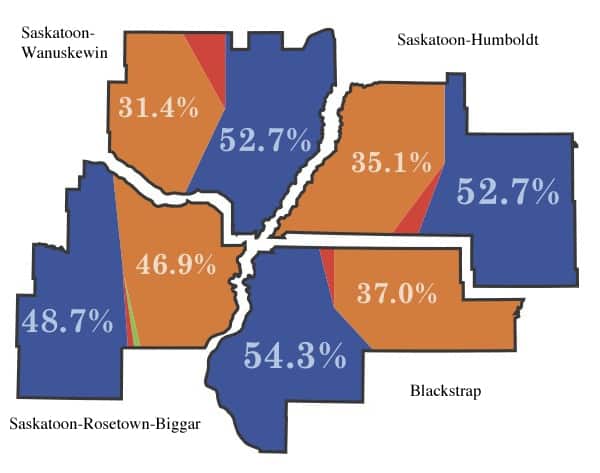TANNARA YELLAND
Senior News Editor
The political makeup of Saskatchewan’s federal representation remained unchanged after an election that saw unprecedented change elsewhere in the country.
The “orange wave” that swept Canada did, indeed, garner the NDP more votes in Saskatchewan, but failed to result in any tangible changes. Every Saskatchewan Member of Parliament elected in the 41st election was an incumbent.

A breakdown of the election results in Saskatoon's 4 federal ridings
In many Saskatchewan ridings Liberal candidates can expect only marginally more votes than perennial also-rans the Green Party.
This was especially true in the Saskatoon-Rosetown-Biggar riding, where NDP candidate Nettie Wiebe lost to Conservative Kelly Block by a mere 262 votes in 2008. Block doubled that margin to a still-uncomfortably-close 538 votes this year.
Wiebe was considered one of the NDP’s best hopes of breaking into Saskatchewan. Party leader Jack Layton made a visit to her riding only four days before the election, drawing nearly 2,000 people. But in a riding where only 1,323 voters chose the Green or Liberal parties, there were not enough left-leaning undecided voters for even Layton’s last-minute presence to affect the outcome of the race.
Elsewhere in Saskatoon the Conservatives had virtually no chance of losing. Maurice Vellacott, Lynne Yelich and Brad Trost were all re-elected with majorities of the popular vote. Trost was the only candidate among the four to lose any support, but in the wake of his comments about defunding the International Planned Parenthood Foundation that made national headlines, a drop of just 1.1 per cent was hardly an indictment of his work or views.
Trost was heavily questioned at the April 21 all-candidates’ debate about claiming to have successfully defunded the IPPF for the past 16 months. He explained that his comments, leaked from a meeting of the Saskatchewan Pro-Life Association, were in reference to the fact that the federal government has neither approved nor denied a late 2009 funding request from the foundation. New funds have not been allocated as the request sits in limbo.
Trost was the only Conservative candidate to appear at the debate. Like many Conservative candidates across the country, Yelich, Vellacott and Block kept largely non-existent public profiles during the campaign. Despite — or possibly because of — this, they each saw modest increases in their share of the vote.
Although the Liberal Party consistently places a distant third in the popular vote in Saskatchewan, Liberal Ralph Goodale is Saskatchewan’s only non-Conservative MP. But his continuous re-election seems to stem more from name recognition and personal loyalty — Goodale was first elected to Parliament in 1974 and has held his Regina riding since 1993 — than from any affection for his party.
When the 2011 federal election began, few people expected it to result in a dramatic reshaping of Parliament that would mirror Saskatchewan’s longtime voting pattern. The “unnecessary, unwanted” election, as Stephen Harper repeatedly phrased it, was supposed to be a staid affair yielding similar, if not identical, results to the previous two elections.
But NDP leader Jack Layton’s performance at the leaders’ debate and his appearance on popular Quebec talk show “Tout le monde en parle” captivated Quebec voters, and they began turning in droves from the separatist Bloc Quebecois. This shift encouraged progressive voters across Canada to reconsider a vote for the NDP, which has often been regarded as a wasted vote.
The “orange wave” continued to snowball, launching the NDP into a second-place finish and an unprecedented 103 seats — the party’s previous best showing, in 1988, netted them 43 seats. Most of those new seats came from Quebec, where the party increased its share from one to 59 seats. But in this new political landscape, with a Conservative majority and NDP opposition, Saskatchewan appears to have been ahead of the curve.
—
graphic: Brianna Whitmore/The Sheaf